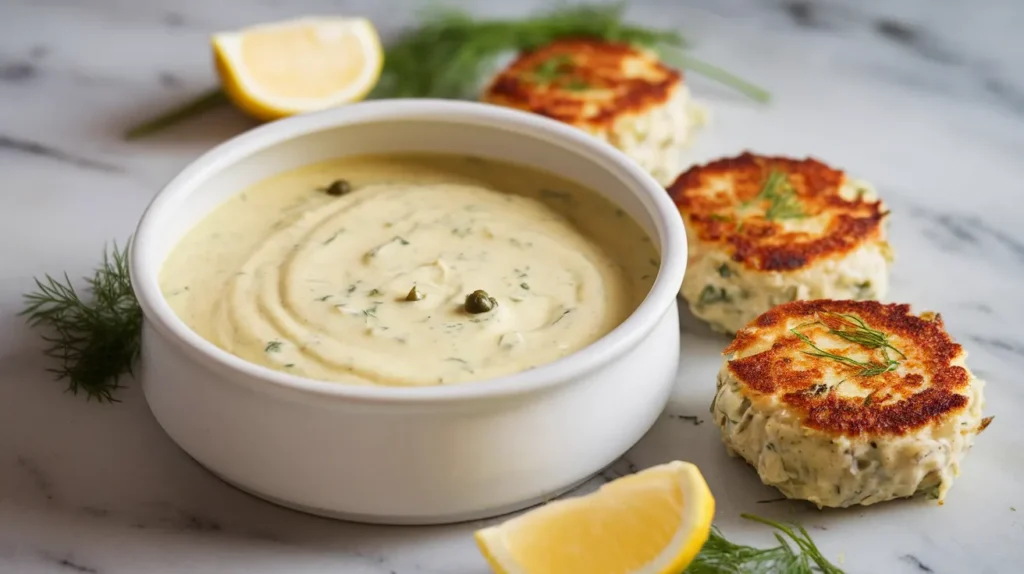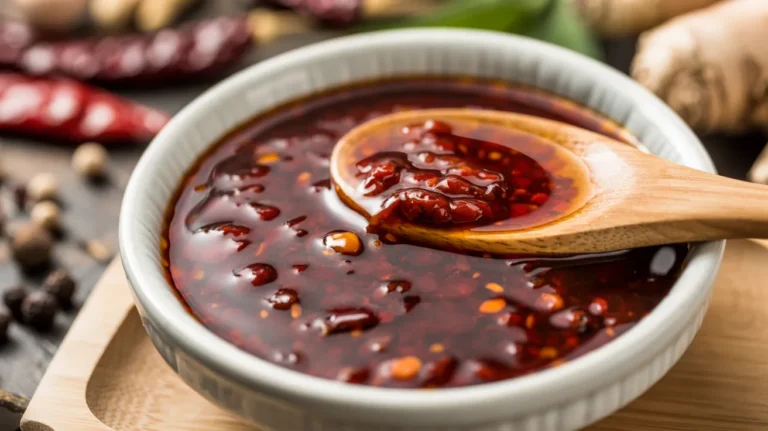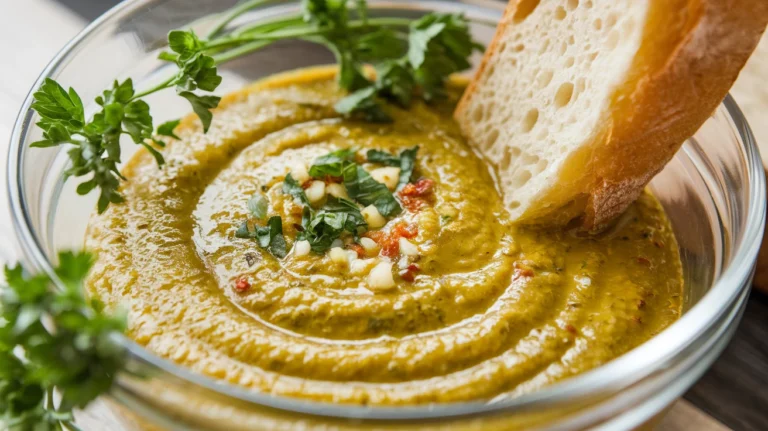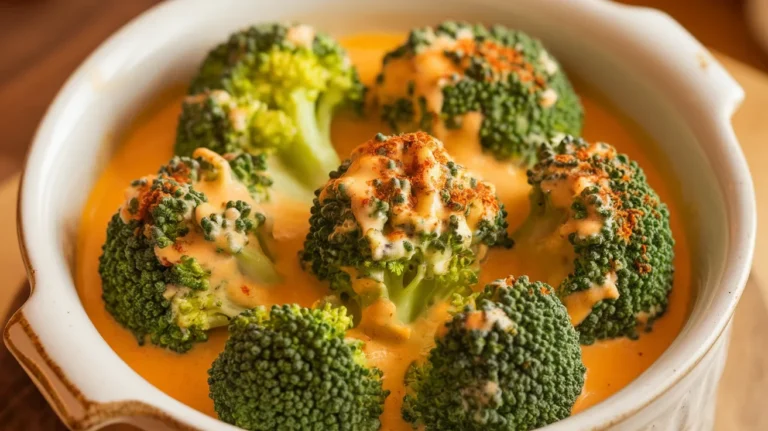This restaurant-quality sauce for crab cakes combines creamy mayonnaise with bright lemon and fresh herbs to create the perfect complement for delicate crab meat. Our foolproof sauce for crab cakes recipe delivers professional results every time, transforming your homemade crab cakes into an elegant dining experience that rivals the finest seafood restaurants.
SERVES: 4 | PREP: 15 MIN | COOK: 0 MIN | TOTAL: 15 MIN
Ingredients for the Perfect Sauce for Crab Cakes
Base Sauce Components
| Ingredient | Amount | Purpose & Notes |
|---|---|---|
| Mayonnaise | 1/2 cup | Use full-fat for richness |
| Fresh lemon juice | 2 tablespoons | Brightens heavy mayo |
| Lemon zest | 1 teaspoon | Adds citrus oils |
| Dijon mustard | 1 tablespoon | Creates tangy depth |
Fresh Flavor Enhancers
| Ingredient | Amount | Purpose & Notes |
|---|---|---|
| Fresh garlic | 2 cloves | Minced very fine |
| Fresh chives | 2 tablespoons | Mild onion flavor |
| Fresh dill | 1 tablespoon | Classic seafood herb |
| Capers | 1 tablespoon | Briny pop of flavor |
| Old Bay seasoning | 1/2 teaspoon | Traditional crab seasoning |
| Fine sea salt | 1/4 teaspoon | Enhances all flavors |
| White pepper | 1/8 teaspoon | Heat without dark specks |
Detailed Step-by-Step Instructions for Sauce for Crab Cakes
Phase 1: Setting Up Your Workspace (3 minutes)
Step 1: Clear a clean workspace and gather all your ingredients on the counter. Place them in the order you’ll use them – this prevents mistakes and makes the process smoother. Beginner tip: Read through all steps before starting so you understand the complete process.
Step 2: Remove mayonnaise from refrigerator and let it sit for 15-20 minutes to reach room temperature. Cold mayo is harder to blend smoothly and may cause the sauce to separate. Visual cue: The mayo should spread easily when stirred, not be thick and resistant.
Step 3: Set up your mixing station with a medium glass or stainless steel bowl (plastic can retain odors). Place a damp kitchen towel under the bowl to prevent it from sliding around while you whisk. Safety note: Wet hands and slippery bowls don’t mix well.
Phase 2: Preparing Fresh Ingredients (5 minutes)
Step 4: Wash and dry your lemon thoroughly under cool running water. Use a clean kitchen towel to dry completely – any water will dilute your sauce. Why this matters: Clean citrus prevents any waxy residue from affecting taste.
Step 5: Zest the lemon using a microplane grater or the fine holes of a box grater. Technique: Only grate the bright yellow part – the white pith underneath is bitter. You need exactly 1 teaspoon of zest. Beginner tip: Zest before juicing because whole lemons are much easier to handle.
Step 6: Cut the lemon in half and juice it using a fork to pierce the flesh and help release more juice. Roll the lemon halves on the counter while pressing down first – this breaks internal membranes and yields more juice. Target: You need 2 full tablespoons of fresh juice.
Step 7: Prepare the garlic carefully by first removing papery skin completely. Place the flat side of your knife over each clove and press firmly to crush slightly – this makes mincing easier. Then mince very finely until no large pieces remain. Why: Large garlic chunks create unpleasant bursts of strong flavor.
Step 8: Wash and thoroughly dry fresh herbs using paper towels or a salad spinner. Chop chives into tiny rounds using kitchen shears or a sharp knife. Chop dill fronds finely, avoiding thick stems. Storage tip: Wet herbs will make your sauce watery and reduce shelf life.
Phase 3: Building the Creamy Base (4 minutes)
Step 9: Measure mayonnaise into your mixing bowl using a rubber spatula to scrape every bit from the measuring cup – wasted mayo means less creamy sauce. Quality check: Good mayo should be thick, white, and smell pleasantly tangy, not sharp or off.
Step 10: Add Dijon mustard to the mayonnaise and whisk them together vigorously for 30 seconds until completely combined. Visual goal: No streaks of yellow mustard should remain – the mixture should be uniformly pale yellow. Technique tip: Use figure-eight motions with your whisk for thorough blending.
Step 11: Slowly add lemon juice while whisking constantly – pour it in a thin stream rather than all at once. Why this technique works: Gradual addition prevents the mayonnaise from breaking or becoming too thin. Visual cue: The mixture should remain thick and creamy, just slightly lighter in color.
Step 12: Add lemon zest and whisk gently to distribute evenly throughout the base. The zest adds tiny bursts of concentrated citrus flavor that complement the crab’s sweetness. Beginner note: Don’t overmix at this stage – gentle folding preserves the zest’s texture.
Phase 4: Incorporating Aromatics and Seasonings (3 minutes)
Step 13: Add minced garlic to the sauce and whisk vigorously for 45 seconds to ensure even distribution. Important: Raw garlic needs thorough mixing to prevent concentrated pockets that could overpower bites. Taste test: The sauce should smell garlicky but not sharp.
Step 14: Fold in fresh chives using a rubber spatula with gentle up-and-over motions. Technique: Folding preserves the herbs’ structure better than vigorous whisking. Visual check: Green chive pieces should be evenly distributed throughout the creamy base.
Step 15: Add fresh dill the same way – gentle folding motions to maintain the herb’s delicate texture. Color goal: The sauce should now have attractive green flecks throughout. Flavor note: Dill is the classic herb pairing with seafood in many cuisines.
Step 16: Drain capers thoroughly and chop them roughly – they should be broken but still have some texture. Stir into sauce gently to distribute evenly. Why capers work: Their briny, pickle-like flavor echoes ocean flavors and adds interesting texture pops.
Phase 5: Final Seasoning and Perfecting (2 minutes)
Step 17: Sprinkle Old Bay seasoning over the sauce and whisk it in completely. Seasoning note: Old Bay contains celery salt, bay leaf, mustard seed, and paprika – all traditional crab cake seasonings. Visual cue: The sauce may take on a very light orange tint from the paprika.
Step 18: Add salt gradually – start with half the amount and taste before adding more. Seasoning rule: You can always add more salt, but you can’t remove it. Taste test: The sauce should enhance flavors without being noticeably salty.
Step 19: Add white pepper carefully – it’s more potent than black pepper. Why white pepper: It provides heat without dark specks that would make the sauce look less elegant. Grinding tip: Fresh-ground white pepper has better flavor than pre-ground.
Step 20: Taste your sauce for crab cakes and adjust – it should be creamy, tangy, and well-balanced. Too bland? Add more lemon juice or salt. Too thick? Whisk in water 1 teaspoon at a time. Too thin? Add a bit more mayonnaise.
Step 21: Cover the finished sauce with plastic wrap pressed directly onto the surface to prevent a skin from forming. Refrigerate for at least 30 minutes before serving – this resting time allows all flavors to meld and develop complexity.
Chef’s Professional Notes for Sauce for Crab Cakes
• Timing is everything – make this sauce for crab cakes at least 30 minutes before serving, but no more than 3 days ahead for optimal freshness and flavor development.
• Quality ingredients matter – use the best mayonnaise you can find, preferably made with cage-free eggs and quality oils, as it forms the foundation of your sauce.
• Fresh herb storage – keep leftover chopped herbs in a damp paper towel in the refrigerator for up to 2 days, perfect for garnishing your plated crab cakes.
• Consistency control – this sauce for crab cakes should coat a spoon lightly but not be so thick it won’t drizzle – adjust with lemon juice or mayo as needed.
Nutrition Information (Per Serving)
- Calories: 185
- Protein: 1g
- Carbohydrates: 2g
- Fat: 20g
- Fiber: 0g
- Sodium: 245mg
- Vitamin C: 8% DV
Creative Sauce for Crab Cakes Variations
Spicy Remoulade Style
Transform your basic sauce by adding 1/2 teaspoon cayenne pepper, 1 tablespoon creole mustard, and 1 teaspoon hot sauce. This Louisiana-inspired variation pairs beautifully with cornmeal-crusted crab cakes and adds Southern flair to your seafood dinner.
Mediterranean Herb Version
Replace dill with fresh basil and oregano, then add 1 tablespoon finely chopped sun-dried tomatoes and a pinch of garlic powder. This variation works wonderfully when you want to complement crab cakes with Mediterranean sides.
Asian-Inspired Fusion
Substitute rice vinegar for half the lemon juice and add 1 teaspoon toasted sesame oil plus fresh grated ginger. This creates an interesting East-meets-West sauce that’s perfect for pan-Asian crab cake preparations.
Avocado Green Goddess Style
Mash 1/2 ripe avocado into the base sauce and add extra fresh herbs for a creamy, green variation. This heart-healthy twist adds richness while reducing some of the mayonnaise, and the green color makes a beautiful presentation contrast to golden crab cakes. For more inspiration, try pairing with our sauce for coconut shrimp for a tropical seafood feast.
Storage & Make-Ahead Tips for Sauce for Crab Cakes
Refrigerator Storage: Store your completed sauce for crab cakes in an airtight container for up to 4 days. The flavors actually improve after the first day as the garlic mellows and herbs infuse the creamy base.
Freezing Guidelines: Never freeze mayonnaise-based sauces – they separate irreparably when thawed and will ruin the smooth texture you’ve worked to achieve.
Optimal Serving Temperature: Serve slightly chilled or at room temperature. Remove from refrigerator 15 minutes before serving for best consistency and to allow flavors to bloom properly.
Make-Ahead Strategy: Prepare all components except fresh herbs up to 2 days ahead, then stir in chopped chives and dill just before serving to maintain their bright color and fresh taste.
Portion Control: This recipe makes enough sauce for 4 generous servings – about 2-3 tablespoons per person, which is perfect for coating crab cakes without overwhelming their delicate flavor.

Complete Troubleshooting Guide
Problem: My sauce for crab cakes is too thick Solution: Whisk in fresh lemon juice 1 teaspoon at a time until you reach the perfect drizzling consistency. If out of lemon juice, use water sparingly – start with 1/2 teaspoon additions.
Problem: The sauce looks curdled or separated Solution: This usually happens when ingredients are too cold or acid is added too quickly. Let everything come to room temperature, then start fresh with new mayonnaise, slowly whisking the separated mixture back in drop by drop.
Problem: Overwhelming garlic flavor that’s too harsh Solution: Balance the bite by adding more mayonnaise to dilute the intensity. You can also stir in 1/2 teaspoon honey to counteract sharpness. Time also mellows raw garlic flavor – let it rest longer.
Problem: The sauce lacks flavor impact or tastes flat Solution: Increase salt first (it enhances all other flavors), then add more lemon juice for brightness. Sometimes sauces need more acid to make all the other flavors pop and come alive.
Problem: Wrong consistency after refrigeration Solution: Cold temperatures naturally thicken mayonnaise-based sauces. Let sit at room temperature for 10-15 minutes and stir gently before serving – never microwave to warm up.
Problem: Herbs look wilted or brown Solution: This means they were added while wet or the sauce is too old. Fresh herbs should be completely dry before adding, and the sauce should be used within 3-4 days for best appearance.
Essential Equipment for Making Sauce for Crab Cakes
• Medium glass mixing bowl – non-reactive material that won’t absorb flavors • Wire whisk – creates smooth texture without lumps or streaks
• Microplane grater or zester – for perfect, fine lemon zest • Sharp paring knife – for precision mincing of garlic and herbs • Separate cutting board – dedicated to aromatics, not used for raw proteins • Measuring cups and spoons – accuracy ensures consistent results every time • Rubber spatula – for gentle folding and complete bowl scraping • Airtight storage container – glass or BPA-free plastic for refrigerator storage • Kitchen towels – for drying herbs and stabilizing mixing bowl
Organized Shopping List
Refrigerated/Dairy Section
- High-quality mayonnaise (1 jar – you’ll use 1/2 cup)
- Dijon mustard (small jar if you don’t have)
Fresh Produce Section
- Large lemons (buy 2 to ensure enough juice)
- Fresh garlic bulb (you need 2 cloves)
- Fresh chives (1 small package)
- Fresh dill (1 small package)
Pantry/International Aisle
- Old Bay seasoning (small container)
- Fine sea salt
- White peppercorns (or pre-ground white pepper)
- Capers (small jar – buy packed in brine, not salt)
Five Success Secrets for Perfect Sauce for Crab Cakes
1. Master the Temperature Game: Room temperature ingredients blend effortlessly while cold ingredients fight you every step. Take mayonnaise out 20 minutes before starting – this single step prevents most texture problems.
2. Respect the Lemon Technique: Always zest before juicing, and add juice slowly while whisking constantly. This preserves the creamy texture while building bright flavor that makes crab cakes shine.
3. Herb Handling Perfection: Completely dry fresh herbs before chopping, then add them last with gentle folding motions. This preserves their color, texture, and fresh flavor impact.
4. Build Flavor Gradually: Taste after each major addition and adjust incrementally. The best sauce for crab cakes balances creamy richness with bright acidity and aromatic herbs – no single element should dominate.
5. Allow Resting Time: Let your finished sauce rest in the refrigerator for at least 30 minutes before serving. This crucial step allows flavors to marry and develop the complexity that separates amateur from professional results. The wait transforms good sauce into the perfect complement for your homemade crab cakes, rivaling any sauce for grilled shrimp you’ve enjoyed at fine restaurants.
This comprehensive sauce for crab cakes recipe ensures beginner success while delivering restaurant-quality results. The detailed instructions remove guesswork, while the professional tips guarantee your sauce enhances rather than masks the delicate sweetness of fresh crab meat.




